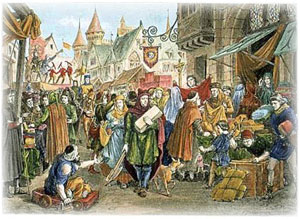Herbs in Medieval Times
Imagine a time when there was no deodorant, shampoo, bath soap, laundry detergent, or an array of pine cleaners and disinfectants. Welcome to the Middle Ages.
With no access to exterminators, medieval people made use of strongly scented herbs to discourage vermin and also to mask the scent of unwashed bodies.
Tansy was grown to discourage flies, lavender cotton against moths, the use of pennyroyal against fleas. Mint was very popular and used to repel mice and ants.
In the homes of peasant and royalty alike, the floors were often dirt. Packed solid from years of people walking over them. Household odors from cooking and sweaty bodies was overwhelming. So, the good people of this period in history resorted to mixing strong herbs with rushes or straw and scattering them about on the floors.
From Thomas Tusser’s Five Hundred Points of Husbandry we have strewing herbs of all sorts.
Bassel- Basil, Bawlme-Lemon Balm, Cameamel- Chamomile, Pennnyryall-Pennyroyal, and so on.
The layering of Linens- Laying herbs among clothing and bed linens, consisted of rose petals, cloves, cinnamon, sandalwood, lavender and mint. ” For a marvellous pleasant in savour, wonderous swetries for the bedde, where by the whole place, shall have a more pleasant scent- 1562 recipe for the laying of herbs among the bed linens.
Sweet Bags or Sachet Bags- Dry and powdered ingredients were sewn up in little pieces of silk or linen to be stored with bed linens and fine clothes. “Take thee orris root, red rose petals, marjoram, and sweet basil, of each ounce, yellow sanders, cloves and musk. Bruise the herbs and spices between the fingers to release the scent. Close up the sweet bags and tuck them in the linens and clothes.
Here is a recipe for the medieval dining room- To make water for hand washing at the table, combine lavender, sage, basil, rosemary, and the dried rind of citrus fruit. Add these to boiling water and cool the water to lukewarm before using. ” Diverse sort of sweet waters, sure to delight the ladies.” No doubt.
Calamus- also known as Sweet Flag, did double duty in the homes. The rushes of sweet flag were strewn on the floors, and the herb was dried and ground very finely for use in body powders. Thereby reducing the flea and lice population somewhat.
Mint and vinegar were used as a mouthwash, and small rosemary branches served as tooth brushes and to pick the teeth between courses at the table.
No one, peasant or royal was allowed to come before the King or Queen without first inserting several cloves in the mouth. The original tic-tac.
A weary traveler stopping for the night at an inn, was offered a simple hand wash, water of rosemary. This rosemary infused water was soap and water for washing the grime away.
In spite of all the precautions, attempts at hygiene- disease, vermin, and infections claimed the lives of millions.
It was the worst of times and the darkest of times.
~ Meadow Walker


Reblogged this on Coven Life and commented:
Check out Meadow Walker’s website-Mysitcal MAgical Herbs for a lot more on using, preserving and growing herbs.